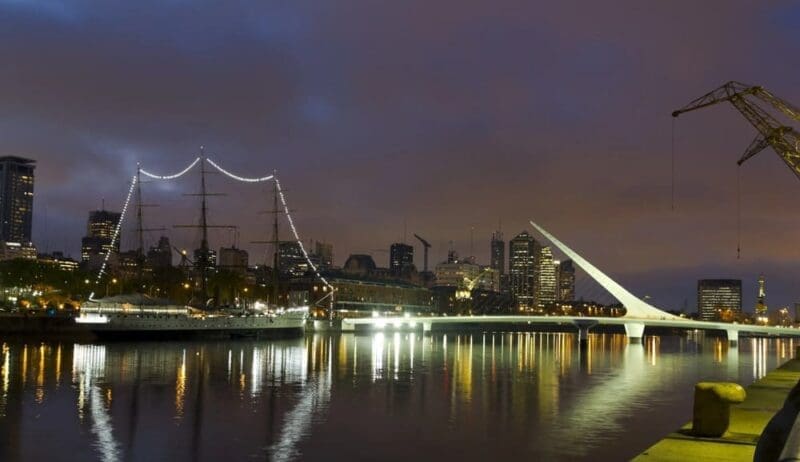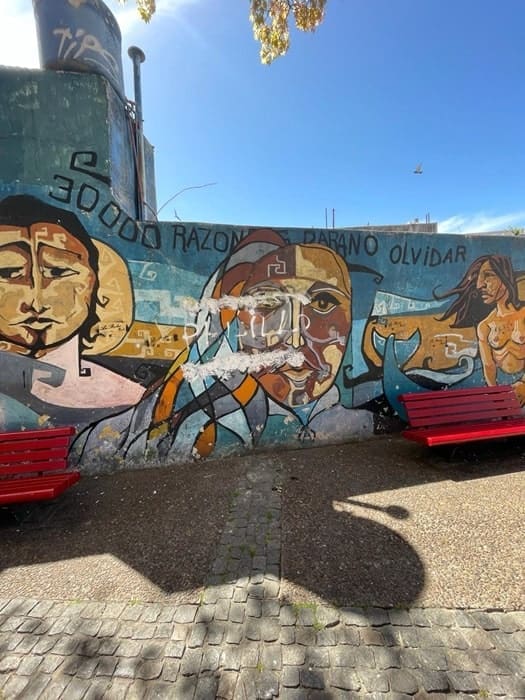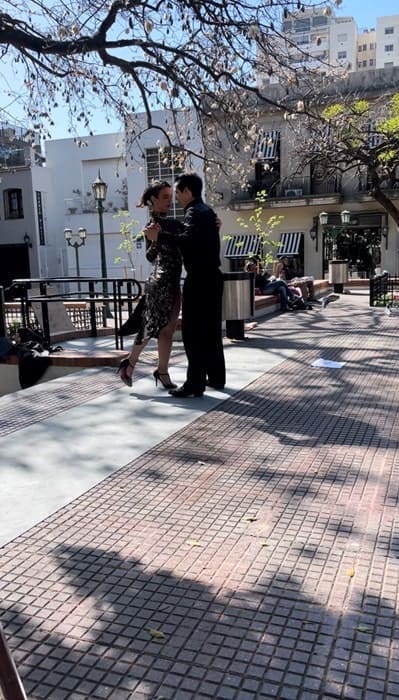Buenos Aires is the capital of Argentina, one of the safest countries in Latin America.
This Europeanised city is a perfect place to ease into South America for anyone who is more used to westernized countries such as those in Western Europe and the USA or Canada.
It combines culture and culinary delights in a city with a lot of history.
Buenos Aires was the birthplace of many famous individuals including Formula One racing champion Juan Manuel Fangio, football legend Alfredo Di Stefano, and even Pope Francis.
Today it is the epicenter of Argentine culture with tango dancers performing on the streets, and affordable steak available in abundance.
An Introduction to Argentine Cuisine
Steak and Asado
When it comes to steak, there is no better country on the planet than Argentina. The high protein content makes it a nutritional option that’s popular amongst locals. This is also the cheapest country in the world to find steak dishes.
Perhaps the jewel in Argentina’s culinary crown is the asado – barbecue. This is an assortment of meats cooked on a parrilla (grill) and often served in large enough portions to feed 2-4 people.
The asado usually consists of asado de tira (ribs), vacío (flank steak), chorizo (sausage), morcilla (blood sausage), and often one or two other cuts. Popular additions include cuadril (rump steak) and ojo de bife (rib eye), although there can be variations depending on the preferences of the asador (chef) and the choice of restaurant.
To get the perfect steak, it is important to be familiar with the following terms:
Vuelta-vuelta: Extremely rare. The steak is blue
Muy jugoso: Very rare. Still very pink with juices flowing
Jugoso: Medium-rare. Still juicy at this point
A punto: Medium. At this stage, there’s very little juice although it’s still pink on the inside
Cocido: Well done. Well-cooked and brown on the inside
Bien cocido: Very well done. Perfectly brown on the inside
Asado can often be served with chimichurri sauce. This green-coloured sauce consists of parsley, vinegar, lemon juice, olive oil, and garlic.
Other Savoury Bites

Argentina is a very meat-heavy country. And even without something as filling as a steak, the most popular foods generally come from animals.
Another local favorite is the milanesa de carne. This cutlet is often made of beef, chicken or pork served in breadcrumbs, although pork is less common. It is essentially the same as the schnitzel you can find in Germany and Austria. The milanesa is often served with chips and salad.
There is also the milanesa napolitana. This version involves the cutlet being covered in cheese and tomato. Sometimes ham is also added, making it a more filling option than the original milanesa.
For something a little lighter, empanadas are the perfect snack and can be found all over Buenos Aires.
These small pastries are filled with various ingredients. They are served either as snacks if one or two are ordered, or full meals for more than two.
Common fillings include beef, chicken, cheese, vegetables and onions. But some can be filled with eggs, sauces, sweet foods, or just about anything else.
Empanadas are a staple of the Argentine diet, and cost less than $2 for a single one. They are a must-try during any trip to Buenos Aires.
Sweet Treats in Buenos Aires
Porteños (port city people), as the locals of Buenos Aires are known, love their desserts just as much as their steaks.
Topping the list of popular treats in the capital are alfajores. These are honey, flour and nut-based pastries, often filled with dulce de leche. They are loved by locals not just in Buenos Aires, but all across South America’s Southern Cone (Argentina, Uruguay, Paraguay, Chile).
Dulce de leche is a sweet blend of condensed milk and sugar, heated until it becomes a spread with a similar appearance to caramel. The locals love it, and many bakery treats will have dulce de leche inside them. It’s hard to avoid it during a trip to Buenos Aires.
Suggested 3-Day Itinerary for Buenos Aires

Day 1: Monserrat, Free Walking Tour, and Dinner by Rio Dique
A slow start is recommended after a long flight. It will take a long time to reach Buenos Aires unless coming from another South American country, so take it easy in the morning.
Monserrat is the best neighborhood to stay in for families in Buenos Aires. The popular Palermo area should be avoided with younger guests due to the abundance of noisy bars and clubs in the area. Monserrat offers a slightly quieter setting, albeit a busy one throughout the day amidst the hustle and bustle of commuters and tourists passing through.
Spend the morning walking around Monserrat and surrounding areas, whilst becoming familiar with the local streets, shops and restaurants.
By mid-afternoon, the perfect way to see the city is via a free walking tour. Free walking tours (tips-based rather than truly free) are the perfect way to become familiar with a new city.
A local will show the highlights of a particular area over the course of 2-3 hours whilst explaining the history of the place.
By doing one, it is easy to find the most fun attractions, the tastiest restaurants and learn local tips about safety, transport links, or anything interesting that may not be found online.
A free tour of the city centre starts at the National Congress with an introduction to Buenos Aires and its history. It then progresses up the famous Avenida de Mayo, best known for its impressive European-style architecture.
The guide will stop at further points of interest including the mural of popular politician Eva Perón – the wife of Juan Perón, whose “Peronist” politics have shaped Argentina today. Rather than “left-wing” and “right-wing”, Argentine politics are generally divided between “Peronist” and “anti-Peronist”, such is the impact that the 1940s power couple had.
Then the tour heads towards Cafe Tortoni. This spot is famous as the oldest cafe in Buenos Aires and a favorite of politicians and celebrities alike. Juan Manuel Fangio, Einstein and Hillary Clinton have all been spotted here since the cafe first opened in 1858. It is also a spot well-known for watching Argentine tango performances.
Next up is Plaza de Mayo and Casa Rosada. The former is the city’s oldest public square and the scene of many major protests and events over the years. The latter is the president’s official workplace, and somewhere that can be visited on a separate tour. Even without an interest in the history, Casa Rosada is a great backdrop for photographs with its iconic pink coloring. After all, “Casa Rosada” is Spanish for “pink house”.
This concludes the 2.5 hour tour, which provides a great introduction to Argentine history and shows visitors a good chunk of the capital.
In the evening, finish off with a trip to the waterfront for dinner. It takes 12 minutes to walk from Casa Rosada towards the Rio Dique and Rio Darsena Sur. In both of these spots, a series of restaurants can be found offering all sorts of cuisine ranging from Argentine to Italian, American, Japanese and more.
Day 2: La Boca and Café Tortoni
One of the most fascinating places in Buenos Aires is La Boca. Start the day with a quick breakfast before taking a taxi for $2-5 to La Boca, in time for an 11am tour. Please note that tours run daily but must be booked in advance.
It should also be noted that the areas surrounding the touristy spots of La Boca are not the safest and have been associated with several robberies. Therefore, taking a taxi is the best way to get here, and leave afterward. Buses run, but taxis are the better option here.
The touristy spots however are very safe and suitable for families as thousands of visitors flock to the area on a daily basis.

The tour will cover four main areas. The first is the waterfront by the Matanza River. Here the guide will explain La Boca’s history, and how it turned from one of the most dangerous areas in Buenos Aires into the safe, vibrant and beautiful spot it is today. There is also a statue here of artist Benito Martin, who was responsible for the area’s transformation to begin with.
Stop two is the main attraction: El Caminito. This colorful street is where all the action takes place in La Boca. Tango dancers perform on a regular basis. There are seemingly limitless steak options, and souvenir shops galore.
Wine and alfajores are amongst the many local favourites sold in this tiny microcosm of Argentine society.
El Caminito’s unique colors make it one of the most picturesque spots in the whole country. Therefore it’s a great place to get some photos.
The third stage of the tour passes many walls covered in street art. The paintings display some of the most important images to the Argentine people. Most notable are those of local football legend Diego Maradona. Maradona played for Boca Juniors, and is adored by the Argentine population for his role in winning the 1986 World Cup among other things.
Who are Boca Juniors? That’s the fourth place the tour guide will stop at and explain. Boca Juniors are the local football team, and the biggest in Argentina. The guide will explain a little of the history, and the tour will come to an end after this.
After the tour ends it is possible to visit the Boca Juniors Museum, which is right next to the finish point. For anyone with an interest in football, this is the perfect spot to learn about the history and see memorabilia related to one of South America’s most famous clubs.
The Boca Juniors Museum tour is self-guided and ends with a visit to the club shop where it’s possible to buy a replica shirt and other merchandise.
Buying tickets for a Boca Juniors game is very hard, a local contact is required. However, this is not recommended for families as matches can be quite intense and violence is not uncommon at games. There have also been multiple reports of fanatical fans snatching tickets from tourists entering the ground. Therefore, sticking to just the museum is recommended for anyone with children.
Be sure to stay in La Boca for lunch and take in some of the amazing street food on offer. And yes, this is Argentina, meaning various cuts of meat are top of the menu at just about every food stall.
In the afternoon, take a bit of a rest, then head back to Cafe Tortoni. This time, it is time to stop here.
The cafe is open from 8am-9pm every day. It is a spectacular setting with its upmarket Parisian decor and has a wide range of items to choose from.
There are numerous sandwiches, salads, pizzas, meat dishes and appetizers to choose from for a main course. Desserts range from Western favorites such as cheesecake or lemon pie, to local treats including alfajores. Then there is the drinks menu which has plenty of coffees, teas and alcoholic drinks to choose from, whilst also offering lemonade and grape or orange juice.
This is a good spot to have dinner, whilst taking in some entertainment for the evening.
The main attraction of this historic cafe is tango dancing. Shows take place daily from 8pm. Tickets can be bought at the cafe itself, and cost around $13. Although this price fluctuates regularly due to the volatile Argentine currency.
Spend some time here, and finish the day on a high note.
Day 3: Los Bosques de Palermo, Recoleta Cemetery and Don Julio

On the final day, spend some time enjoying the many green spots that Buenos Aires has to offer. Los Bosques de Palermo (El Parque 3 de Febrero) is the most popular that the city has to offer.
Spend the morning walking around and enjoying sights such as the rose garden where many flowers bloom. Rent a paddle boat to enjoy some time on the water. Then visit the park’s planetarium where they host multiple exciting shows on a daily basis educating about space and the universe. All of the above are perfect for families with children of any age.
In the afternoon, head to Recoleta and check out the cemetery. It is the resting place of Eva Peron but is especially well-known for its beautiful graves and sculptures.
Lastly, head back to Buenos Aires for the evening. And stop for dinner at Don Julio. This traditional Argentine restaurant was named as the 19th-best in the world in 2023, the 4th-best in South America, and the best in Argentina.
Reservations are required and should be sorted in advance. Reservations often open around 90 days beforehand and go fast, therefore it is necessary to be quick to book a table. The restaurant opens from 11:30am-1am every day with a 3-hour closure from 4pm-7pm.
This prestigious restaurant is the perfect setting to bring down the curtain on a 3-day visit to Buenos Aires. An enjoyable travel destination for anyone.


